Should we take a picture with the fruit lady? Or not? It is a very touristy thing to do in Cartagena. The lady looked intently at us, and we went for it. Her traditional Colombian attire in flashing yellow and blue with her fruit basket just made us weaker, and why not?
As we looked around, the remaining of the colonial architecture, Botero’s ‘fat lady’ statue and the vibrant neighborhood from Gabriel Garcia Marquez’s writing pad had already engulfed us into the mood.
There are two faces of this town on the Caribbean coast of Colombia. On one end, there is the colorful colonial old area from the Spanish days and on the other, a skyscraper-laden city with modern amenities.
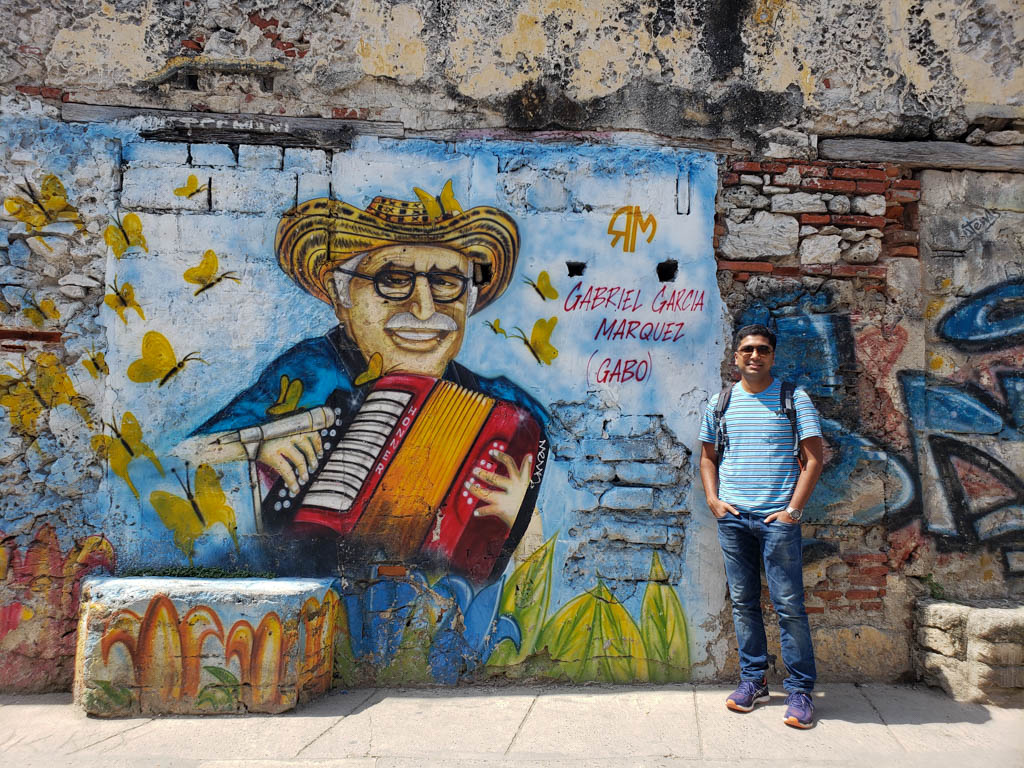
Things to do in Cartagena
Cartagena has been a hotspot for the travelers on their Colombia itinerary. We collaborated with some of our fellow travel bloggers to curate this list of things to do in Cartagena, combining some must-do regulars and some other not so common ones.
Walking tour of Cartagena Old Town
The easiest way to immerse into the history of the colonial town is to take one of the free walking tours. These are guided group tours scheduled at different times of the day. You don’t need to pay anything but definitely tip the guide.
Check the tour schedule and book a slot in advance. The tour lasts for roughly 2 hours. There is no break in between, so do not forget to carry some water. We had booked our free walking tour with Free Walking Tour Cartagena.
The walled city of Cartagena, a UNESCO World Heritage Site since 1984, is witness to hundreds of years of rich history and cultural heritage. The guide takes you through the history of the colonial times, slavery, old architecture to the aspects of modern arts that adorn the walled city.
Just like Medellin, the walking tour works as an introduction to this old city. Use this tour to pick things that interest you to explore in detail later.
The tour usually passes by the Clock Tower (you will probably pass through it multiple times during your stay), the San Pedro Claver Square, the Palace of Inquisition, the Simon Bolivar Park, the Santo Domingo Plaza to name a few.
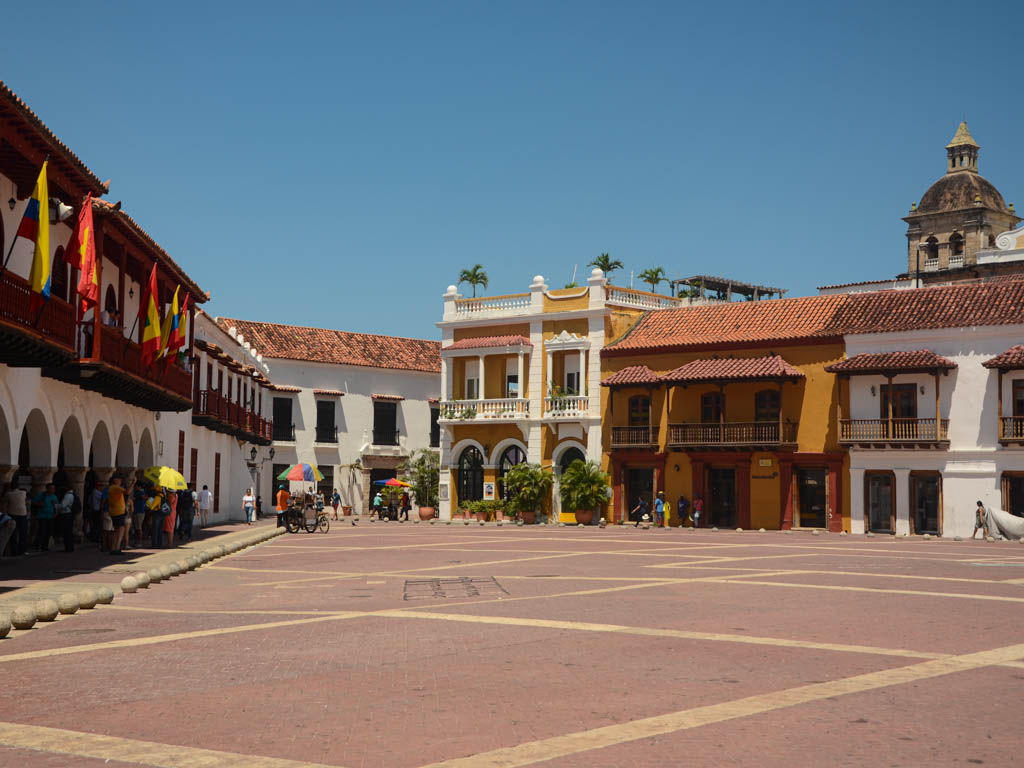
Explore Parque de Bolivar, Palace of Inquisition and surrounding places
The walking tour provides a quick overview of some of the important places within the walled city. However, the places around the Parque de Bolivar deserve separate visits.
Parque de Bolivar
The Parque de Bolivar or Plaza de Bolivar is couple of blocks away from the wall. It is a small plaza where the locals relax under the shades of the trees to beat the Caribbean heat. The center of the plaza has a bronze statue of Simon Bolivar installed in the 19th century.
Palace of Inquisition
The palace is on one side of the Parque de Bolivar. Being completed in the 18th century, the palace is witness to the period of inquisition. It displays artifacts and trial grounds meant for non-believers during the time of inquisition. Despite the dark past, the museum is an exquisite specimen of colonial architecture. It is a place to learn about the history of Cartagena when it was a gateway of commerce in South America.
Museo del Oro Zenu
The Museo del Oro or the Museum of Gold, as the name suggests has an amazing collection of gold artifacts. You learn how the history of Cartagena is tied to gold from the indigenous Zenu tribes.
Catedral de Santa Catalina de Alejandria
The Catedral de Santa Catalina de Alejandria or the Cartagena Cathedral is a pretty church with a gorgeous entrance. It is located close to the Parque de Bolivar. The top of the cathedral is visible from many streets in the walled city and creates a beautiful background to the colorful houses.
Parque de Bolivar Catedral de Santa Catalina de Alejandria
Pose next to Botero’s La Gorda Gertudis
Fernando Botero, a Colombian artist, is known for his creations of oversized figures in his artwork. One of his creations is displayed in Plaza Santo Domingo, the statue of La Gorda Gertrudis (“The Fat Lady”) in the walled city of Cartgena. You will see the sculpture of the lady lying casually facing the church at a corner of the plaza.
It is fun to get clicked with the statue. We have seen people go all the way to try posing for that perfect photo.
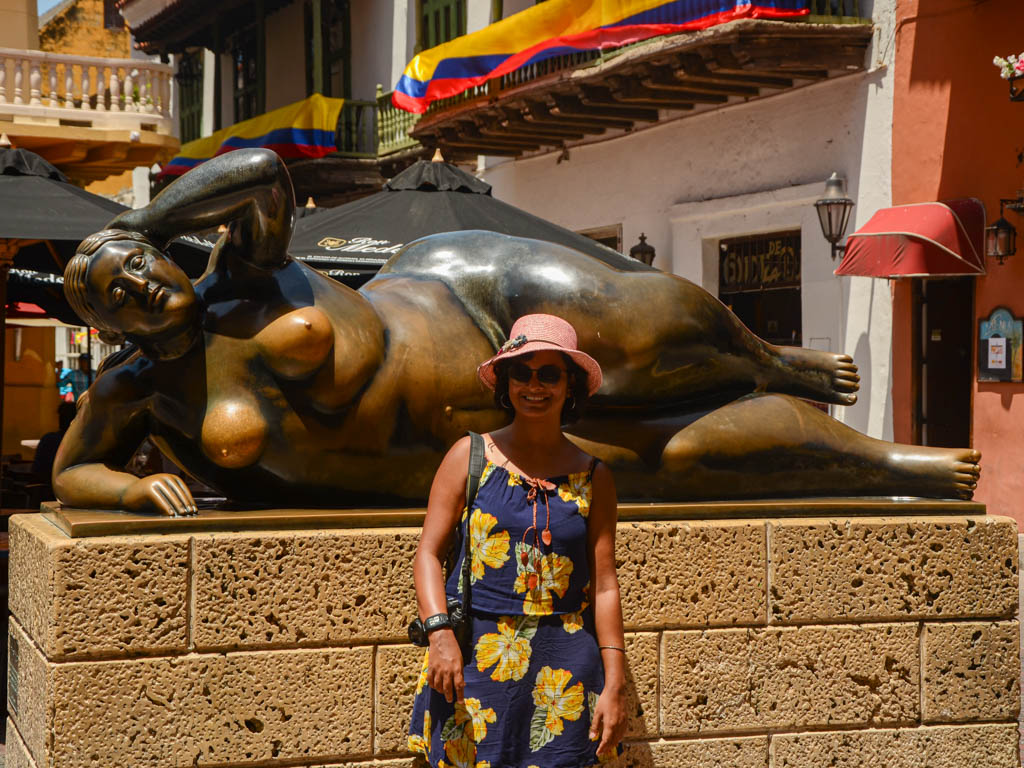
Check out the Colorful Doors and Metallic Doorknobs of Cartagena
Instagram or not, the doors of Cartagena work as perfect backgrounds for your travel photo album. The doors come in different colors, sizes, exquisite colonial styles and designs. These marvellous pieces will make you wonder ‘what lies beyond?’. However, even if you cannot take a sneak peek behind the door, no one is stopping you from making them part of your memories.
The knobs or aldabas need special mentions. Most of them are huge metal figures of animals, like lizard, lion, seahorse, fish and make the doors more interesting to look at. It seems the type of animals signifies the livelihood and social position of the ancestors during Spanish rule. Example, a lion doorknob on the door means someone who is in military whereas a marine animal signifies a job at the sea, whereas lizard indicated royalty.
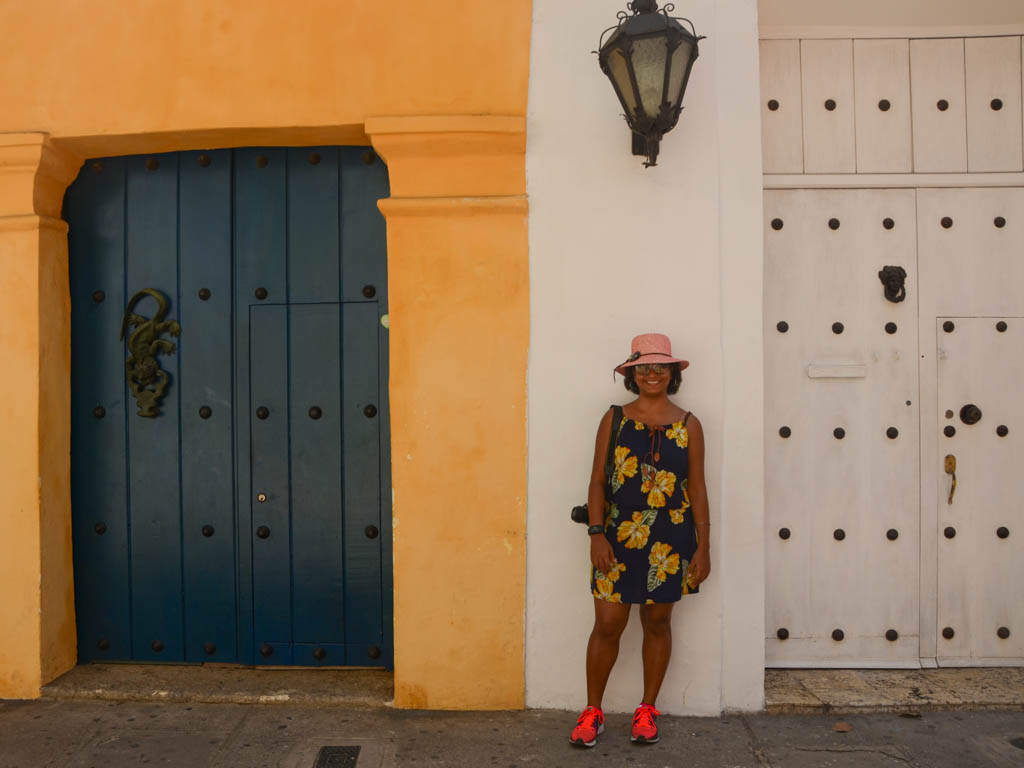
Explore the Street Art in Getsemani
Contributed by: Sam from My Flying Leap. You can also find her on Facebook.
Cartagena is one of the most popular places to visit in Colombia. It is charming inside the city walls, filled with lots of brightly colored buildings, incredible shops and restaurants, and festive squares. There is a lot to do in this historic area.
Just outside the city wall is the best part of the city—a neighborhood called Getsemani. The houses are just as colorful, and this is where the locals live. Getsemani gives you a different, more authentic perspective of Cartagena.
Wander the back streets to see where the locals live. You will see neighbors catching up on their day, kids playing soccer on the road, and some of the most breathtaking street art.
The walls are covered by murals in Getsemani, so it is worth wandering all through this neighborhood. You will see a range of passionate novices to truly noteworthy art and everything in between. The street art in Getsemani reflects the soul of the Colombian people and makes this neighborhood a special place to visit.
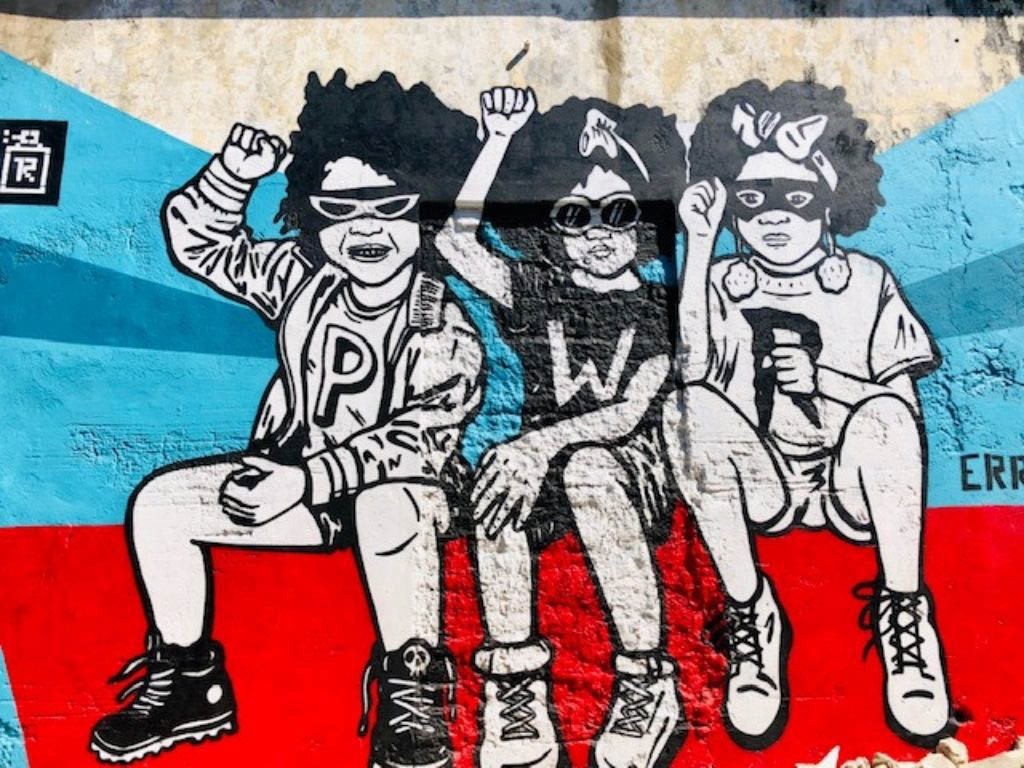
Visit the Clock Tower
Probably the most prominent landmark of old Cartagena and the gateway to the walled city, the clock tower or Puerta del Reloj is another great specimen of the colonial architecture.
The tower was originally built in the 17th century as a connector between the old city and Getsemani. It was repaired and rebuilt to its current form in the 19th century. If you are staying inside the walled city or Getsemani, it is difficult to miss the tower. This place also works as a meeting point for various tours.
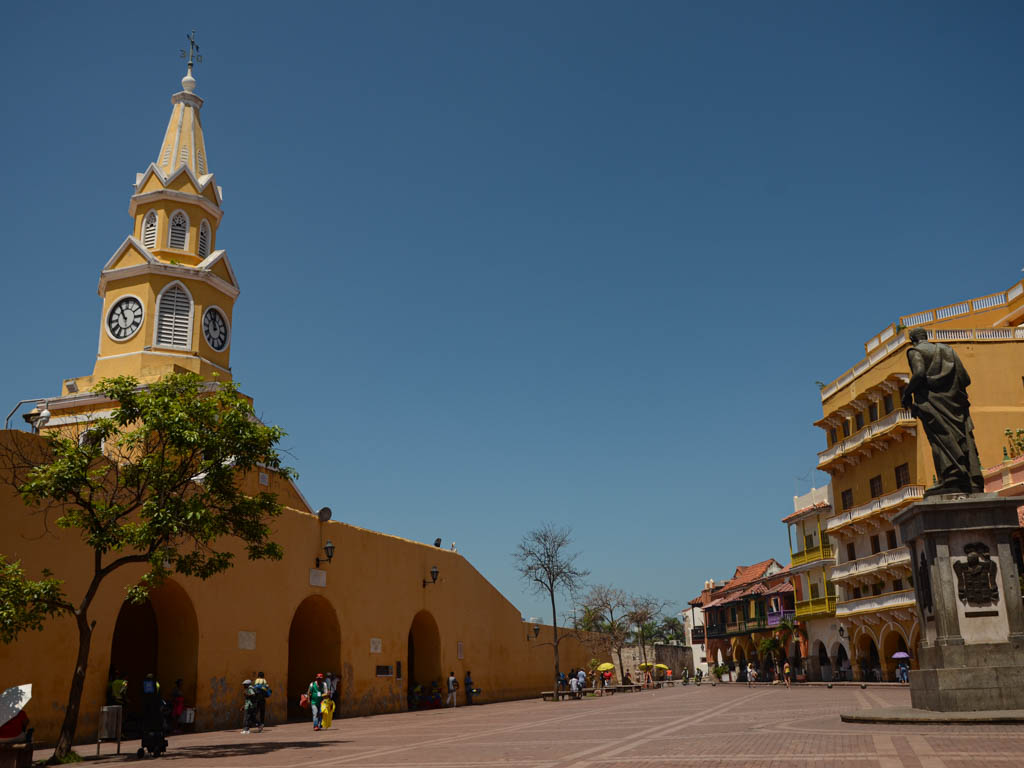
Plaza de la Trinidad
Contributed by: Geena from Beyond The Bucketlist. You can also find her on Instagram.
To experience a more authentic local version of Cartagena, it is important to get outside the walled city. Plaza de la Trinidad is a beautiful mix of local culture and tourist attraction. Every evening after sunset the soft yellow plaza comes to life, locals gather with white styrofoam coolers filled with cheap beer, venders start slinging Colombian style burgers and street food, and travelers settle into the restaurant balconies with their cocktails.
It is a nightly community gathering and a great place to get a feel for the Colombian culture. The Caribbean coast of Colombia seems to be a completely different country when compared to the rest of Colombia. Cartagena is at the heart of this culture.
Music plays, performers dance around, and drinks flow. Plaza de la Trinidad is one of the least touristy tourist attractions Cartagena has to offer. Once you have finished taking in the scene you can dine at the restaurants and bars surrounding the square. It is the perfect end to any evening in Cartagena.
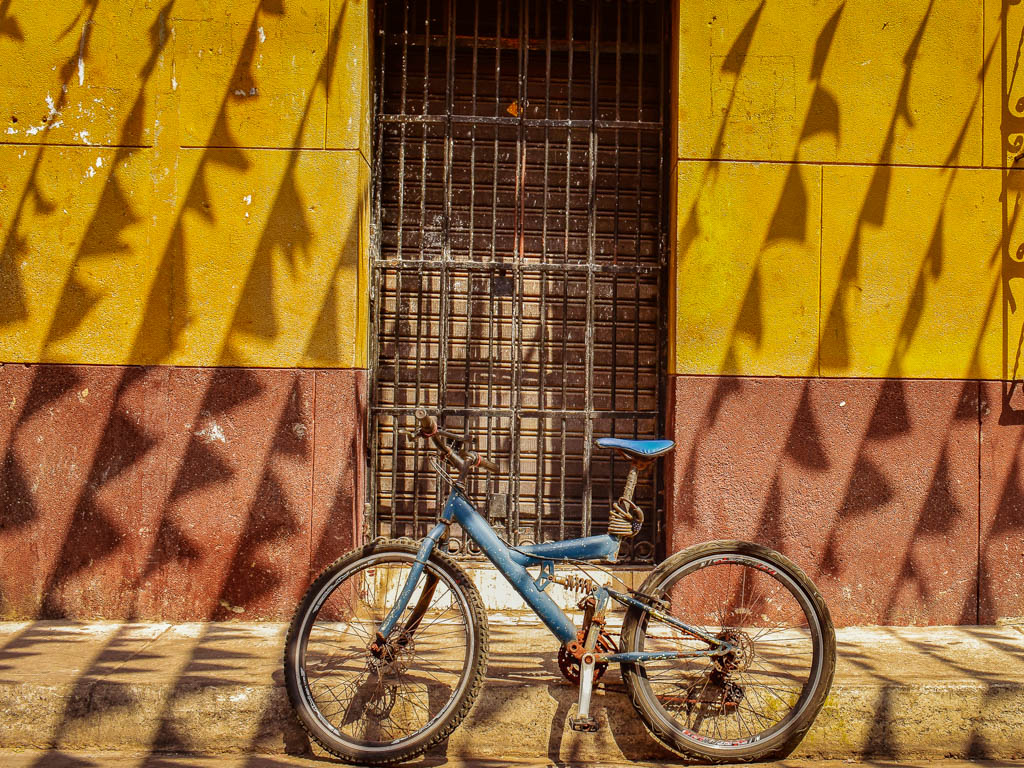
Visit Castillo de San Felipe de Barajas
Contributed by: Maartje & Sebastiaan from The Orange Backpack. You can also find them on Instagram.
Castillo Felipe is one of the main highlights to visit when exploring Cartagena. This old fortress will give you a short insight into Cartagena’s history and offers great city views.
The fortress is located on the other side of the riverbank than most tourist attractions. You can easily walk there though from the old town. Make sure to visit the castle in the early morning, as it can get quite hot on the castle during the afternoon.
The Cartagena castle is one of the many historic attractions around town, telling you about the colonial city’s history in a short documentary film. Start your visit with this video to get a full understanding of the castle you are visiting. The film will tell you how the old fortress used to protect the city from pirates and English invaders.
Besides the history, the castle is interesting to visit for its great city views from the old towers. The underground corridors are open to visitors and are fun to walk through as well.
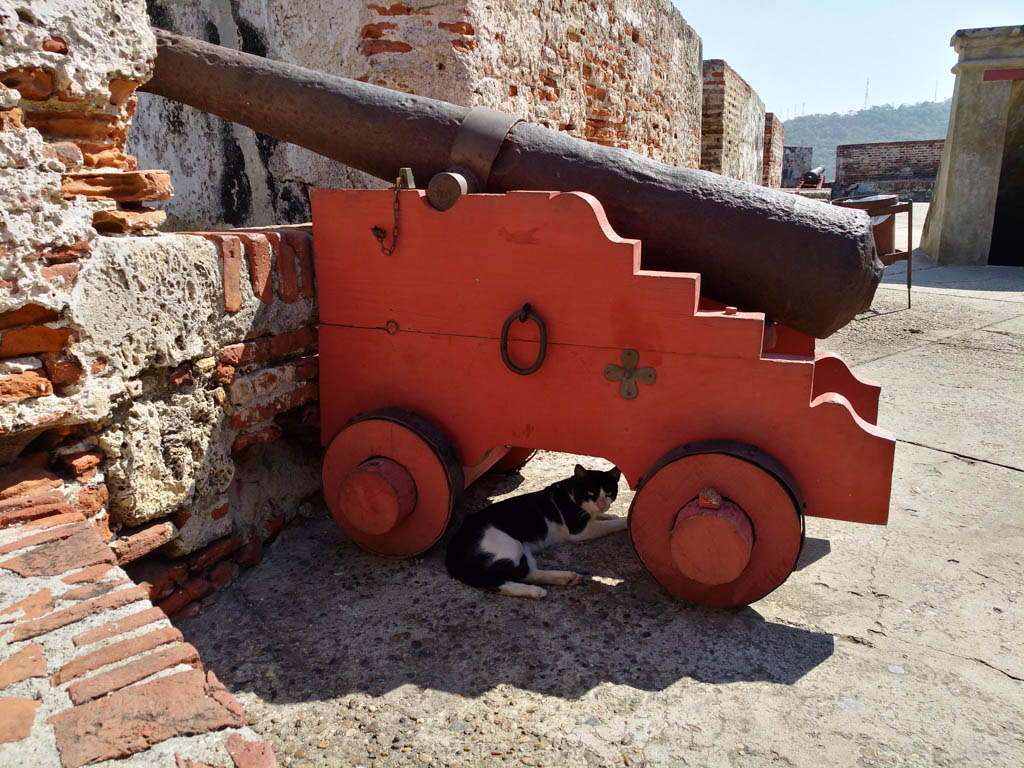
Visit the Lesser Known Forts in the Outer Bay
Contributed by: Adam McConnaughhay from Cartagena Explorer, find him also on Instagram.
The Castillo San Felipe is well known for its massive size, so it is no surprise that it is one of the top things to do in Cartagena. If you like old forts and the fascinating history of Cartagena, you should consider visiting the lesser known fortifications as well, in Bocachica, on the island of Tierra Bomba, at the entrance to the city’s bay.
The Castillo San Fernando is the largest among them and forms a crossfire with the Fort San José, which sits on the other side of the narrow channel (hence the name Bocachica, literally translated as small mouth). Meanwhile, Fort Angel San Rafael sits on a hill and was meant to cover the land approaches to the Castillo San Fernando.
Tips to visit the Lesser Known Forts
There aren’t any organized tours to these forts. Small water taxis that take the residents of the island can be taken from gate number 3 of the tourist docks at El Muelle del Bodeguita, just outside the Walled City near the city’s convention center. You will want to get out either at the docks in the town of Bocachica, or sometimes the water taxi arrives to the dock outside San Fernando. To get to San José, you will have to hire another boat to take you across. Usually there are fisherman around who will be happy to make a few easy pesos. We paid 20,000 for one to take us across and wait 20 minutes or so while we walked around.
It is highly recommended that you know at least basic Spanish, are comfortable with being on the boat, and have some comfort dealing with guys hustling you to sell you a tour. While not the easiest or most organized tourist experience, the forts are wonderfully preserved and a very interesting visit for the history buffs.
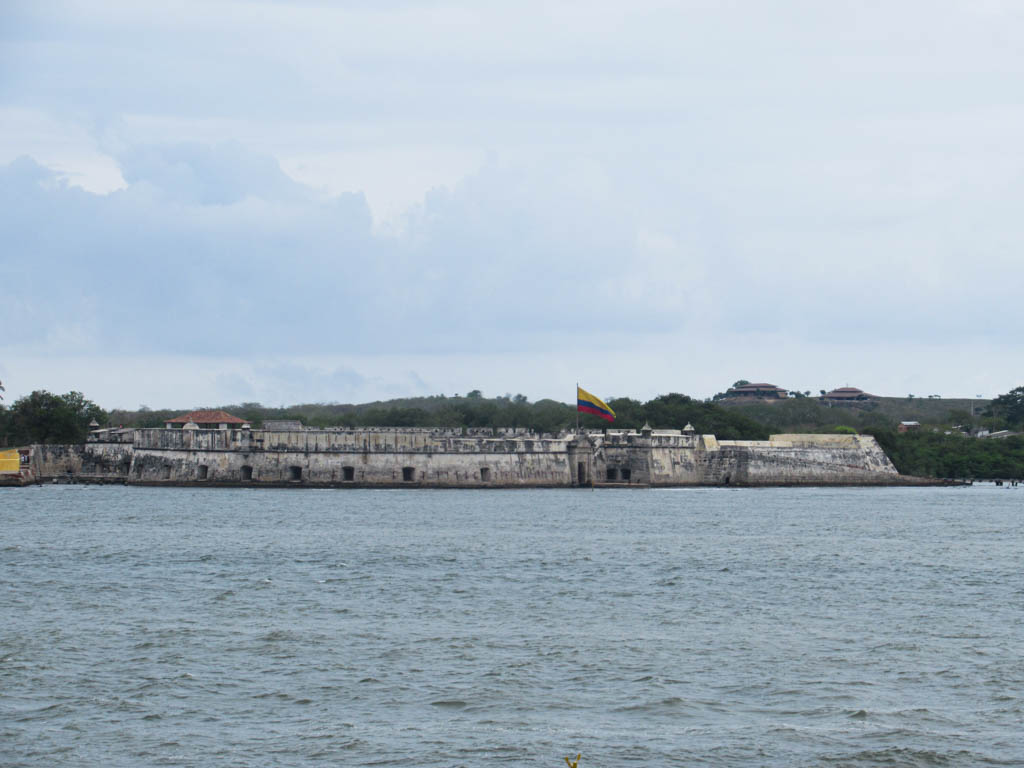
Visit the Naval Museum
Contributed by: Adam McConnaughhay from Cartagena Explorer, find him also on Facebook.
Although lesser known than the Inquisition Museum, Cartagena’s Naval Museum, or the Museo Naval del Caribe, is possibly the best historic museum in the city. It is located just behind the San Pedro Claver Church inside the Walled City.
Downstairs, you will find exhibits on the city’s colonial period, including some really great dioramas of the city’s fortifications and the various attacks on the city. It really helps to put sites like the Castillo San Felipe into context and give you a better understanding of how it, the walls, and the forts in the city’s outer bay defended it.
Upstairs, you’ll find exhibits on Cartagena’s key role in Colombia’s independence and exhibits on the modern Colombian navy, including its little known role in the Korean War. Finally, there are some neat, interactive models of a submarine and destroyer bridge, something that any children along with you will enjoy.
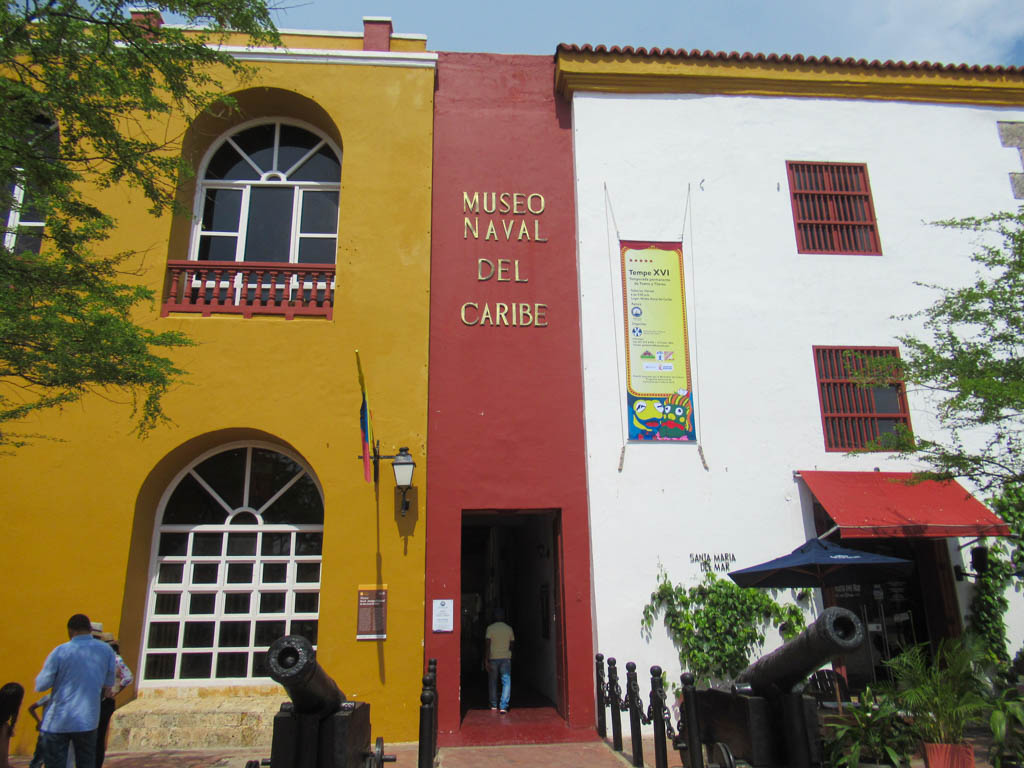
Join a Street Food Tour
Contributed by: Daniel and Ilona of Top Travel Sights. You can also find them on Facebook.
Joining a street food tour is one of the best things you can do in Cartagena.
You can find street food vendors all over the city, selling both sweet and savoury delicacies. Joining a tour allows you to learn more about those dishes and to discover food you would not have found on your own.
One of the most famous street foods in Cartagena that you can also find in other corners of Colombia is Arepas. These corn patties come in different shapes and tastes. Arepa choclo, for example, consists of giant corn.
If you are looking for an unusual flavor combination, you should try Mango Biche. This green mango is not quite ripe yet, so it is not as sweet as yellow mango, and its flavour contrasts with the salt and lemon dressing on top.
Street food tours take place almost daily and cost around 30$ per person.
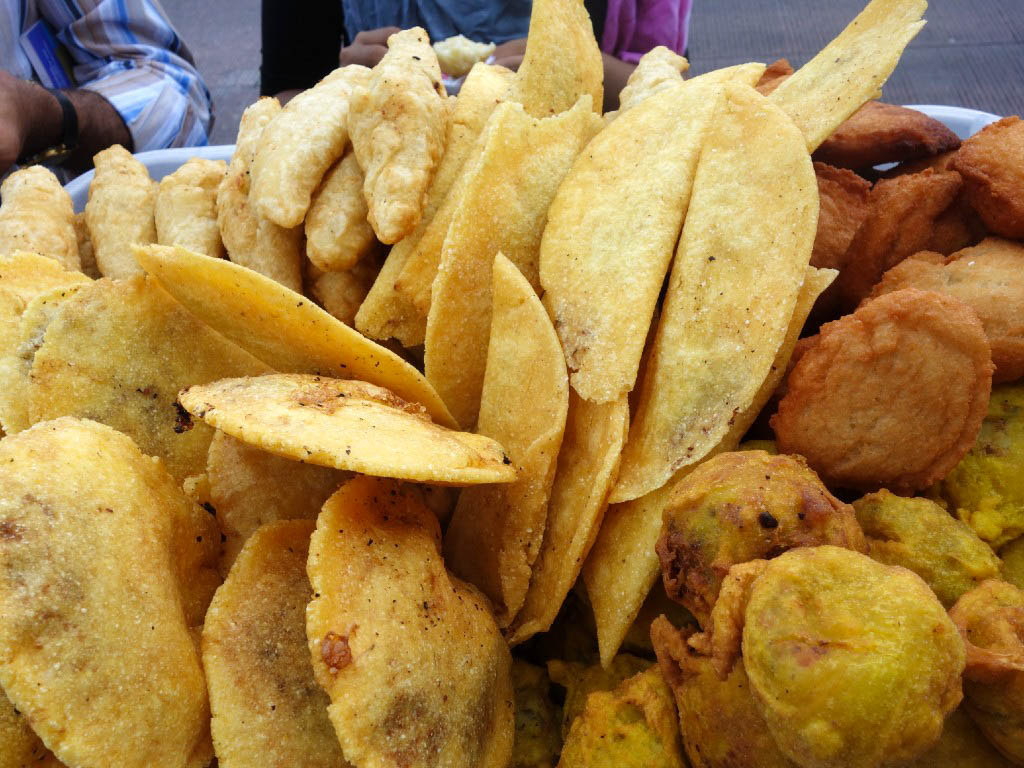
Eat inside a Women’s Prison
Contributed by: Sarah from A Social Nomad. You can also find her on Twitter here.
This activity in Cartagena is likely to set you up as unique. Eating inside a women’s prison is not something many tourists would brag about, but here, inside the walls of the city of Cartagena, it is a good thing to do.
Restaurante Interno has been set up inside the central Cartagena women’s prison of San Diego. This NGO provides paid work-based training for inmates. The staff who cook, serve your food and clean up after you are all inmates. And yes, you eat inside the prison walls.
This unique restaurant operates for dinner only and with a set menu that includes a starter, entrée and dessert. Fruit juice is also included, wine is available as a separate purchase.
Bookings are only via email, phone or WhatsApp and payments are via credit card or if you have cash, then Colombian pesos.
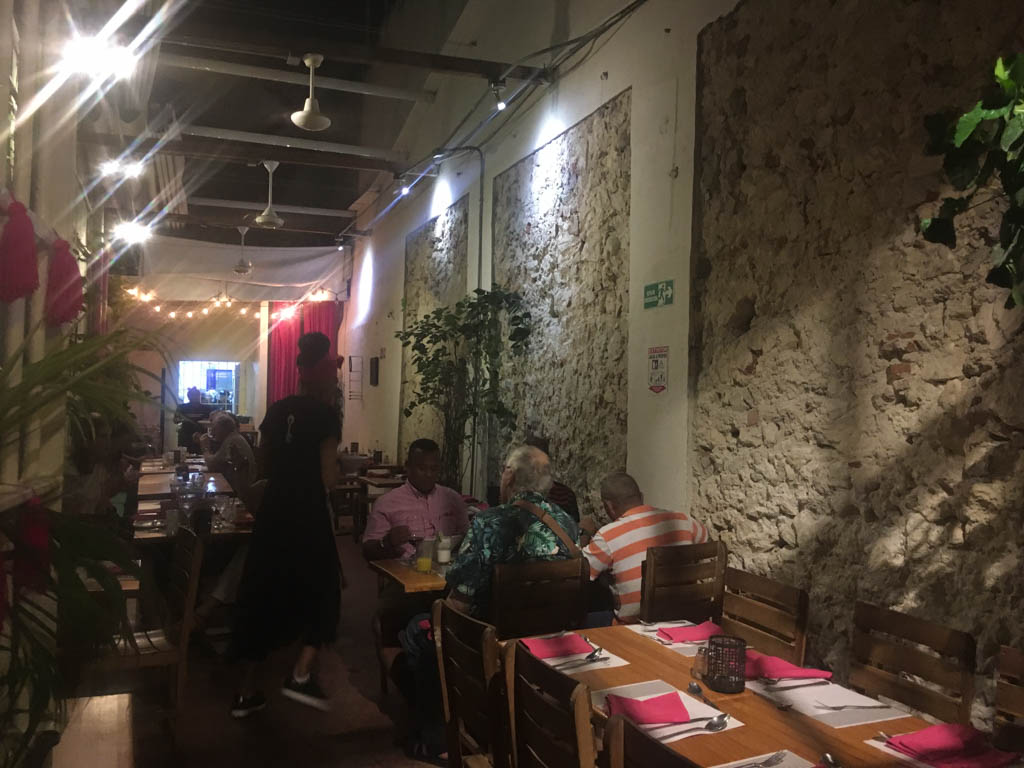
Taste Colombian Caribbean Seafood
We love to try the local cuisine of the places we travel to. As you have already seen, the food scene at Cartagena is pretty diverse, ranging from street food to prison restaurant, and everything in between.
Given Cartagena’s location by the sea, fresh seafood is commonly available here. The seafood is cooked in a typical Caribbean style and is usually served with rice & beans and patacones.
So, when in Cartagena, indulge in some delicious Colombian Caribbean seafood fare. We enjoyed dining at the restaurants La Cocina de Pepina and La Mulata during our visit.
Sunset Drink at Cafe del Mar
Who does not like to watch a lovely sunset by the sea! Cartagena’s position by the Caribbean Sea allows for some stunning orange sunsets in the backdrop of the city skyline.
Cafe de Mar is a popular spot for locals and tourists alike, to watch the sunset everyday. Go early to this rooftop cafe to find yourself a good spot. Grab a drink of your choice and fix your gaze at the fiery sky as it sets to deliver yet another memorable performance.
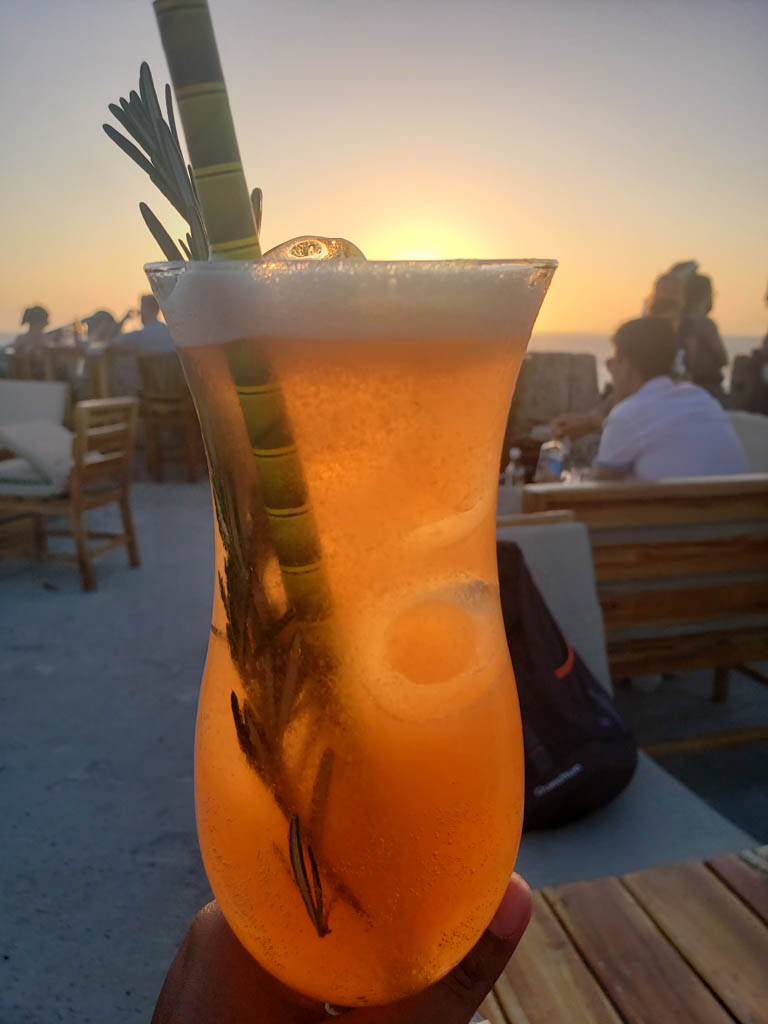
Salsa Nights at Cartagena
Contributed by: Lozzy of Cuppa to Copa Travels. You can also find her on Pinterest.
It wouldn’t be a trip to Colombia’s Caribbean coast without an evening spent in one of the many salsa bars of Cartagena! This city is known across Colombia for its sweltering nightlife, so you can find a huge variety of bars in which to dance the night away. Probably the most famous is Dónde Fidel, which sits conveniently on the clocktower square, near the Hard Rock Cafe. This is a no-frills bar with plenty of outdoor seating for those who cannot handle the heat of the salsa spins that go on inside.
While Dónde Fidel is usually first on people’s lists, I would also suggest a visit to the much swankier Café Havana, outside the city walls in Getsemaní. It is a bit pricier (still very cheap by North American or European standards) and you will want to dress up a little more. But you will realise that it is all worth it when you step into an awe-inspiring time machine with live bands, walls full of old portraits and a vibrant atmosphere.
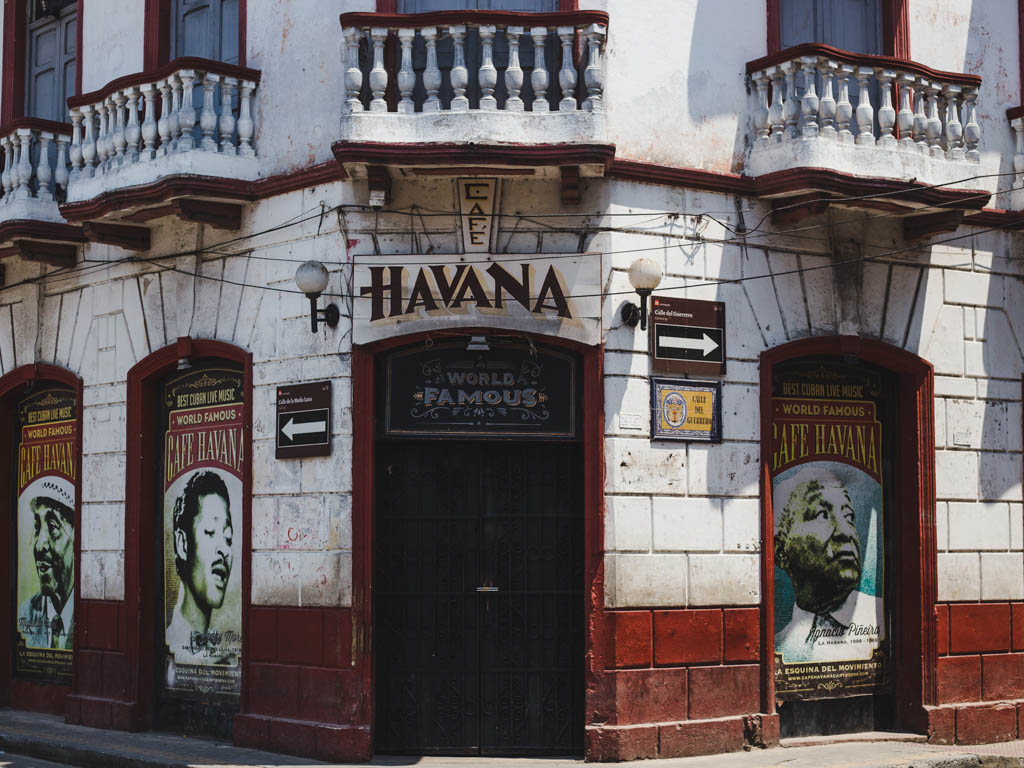
Buy Fruits from a Palenquera
A common sight on the streets of Cartagena is Colombian women, clad in colorful traditional dresses, selling fruits. The blend of colors and texture of the tropical fruits, the women’s silky dresses and the lines of wisdom on their sun-tanned faces create for perfectly photogenic subjects, what people may refer to as Instragrammable.
These women, who come to Cartagena to sell fruits from a nearby town Palenque, are called Palenqueras. You can either buy fruits from the Palenqueras or photograph them or both. Palenqueras have kind of become the iconic faces of Cartagena. They happily oblige to strike a pose for your photograph, as they are aware that this is one of the favorite things to do in Cartagena among tourists. However, please be kind to tip the Palenquera when she happily becomes the subject of your memorable travel photographs.
The Palenqueras actually carry a much deeper history. The people of Palenque were originally runaway slaves from Africa. They worked hard to earn themselves a life of respect. In fact, the town of San Basilio de Palenque was the first ever free town for Africans in the Americas. The struggle for creating an economy led the poor women of Palenque to come to the nearby big city Cartagena to sell what they had in abundance, fruits. Thus started the journey of the famous ‘Fruit Ladies of Cartagena’ aka Palenqueras.
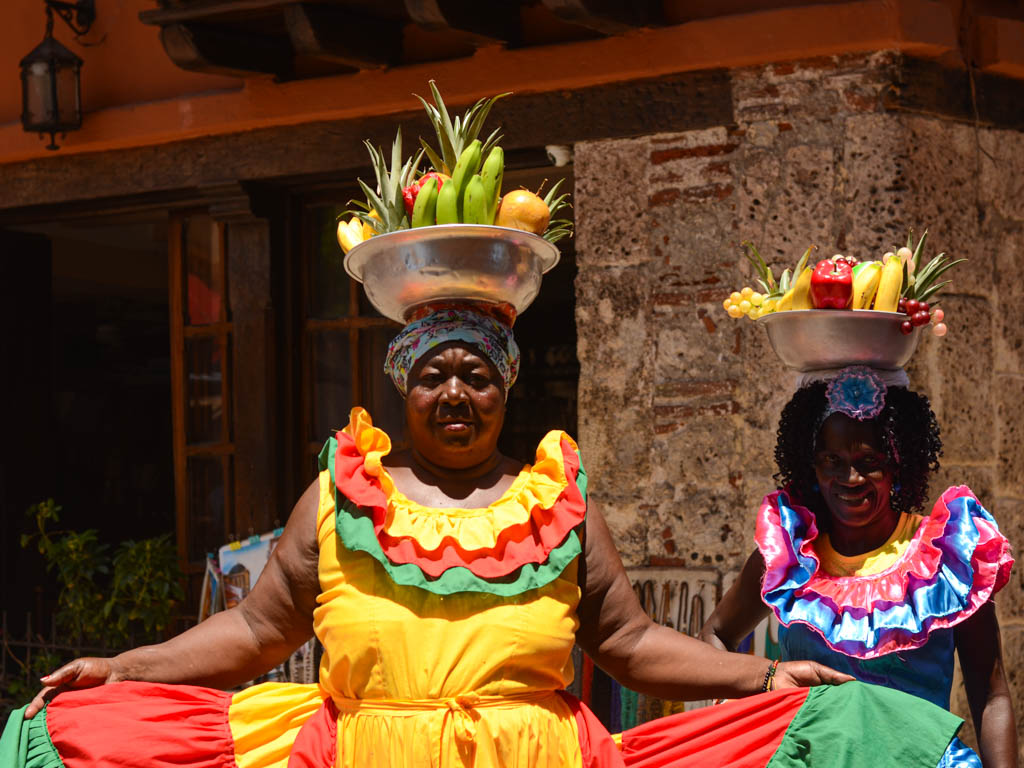
See Sloths at Parque del Centenario
Contributed by: Demi from Around The World With Her. You can also find her on Instragram here.
Right in the centre of the city is an absolute hidden gem! Not many tourists know, but there are sloths in Cartagena! These sloths are completely free roaming and in the wild.
Not too far from the famous neighbourhood of Getsemani you will find Parque del Centenario. It is a small park and not often frequented by tourists. Head inside and keep your eyes peeled on the trees above. There are at least three sloths in the park. Thanks to the small trees, you can see them quite close.
You may also see some tamarin monkeys and iguanas if you hang around. If you cannot see the sloths, there are always locals happy to point them out so do not be afraid to ask them.
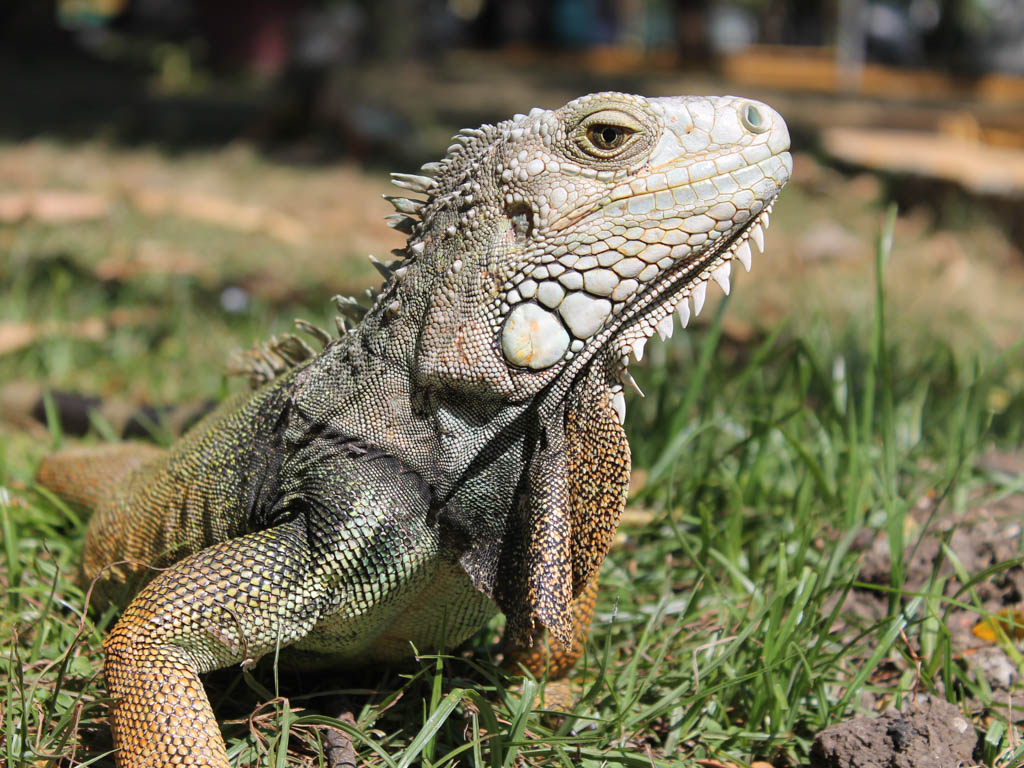
Visit Espiritu del Manglar Park
When looking for the best things to do in Cartagena, be sure to get outside of the walled city and head to Espiritu Del Manglar Park. There you will find a beautiful and fun open area which is open to visitors of all ages. Even carry some delicious local Colombian food from one of the nearby street stands and sit on one of the many benches whilst you admire the iguanas roaming around. The statues on display showcase notable people from Cartagena with many artists and writers including the famous Gabriel García Márquez. The park reminiscent of an oasis and with many common areas, you can sit down, relax and give yourself a break from the hustle and bustle of the city.
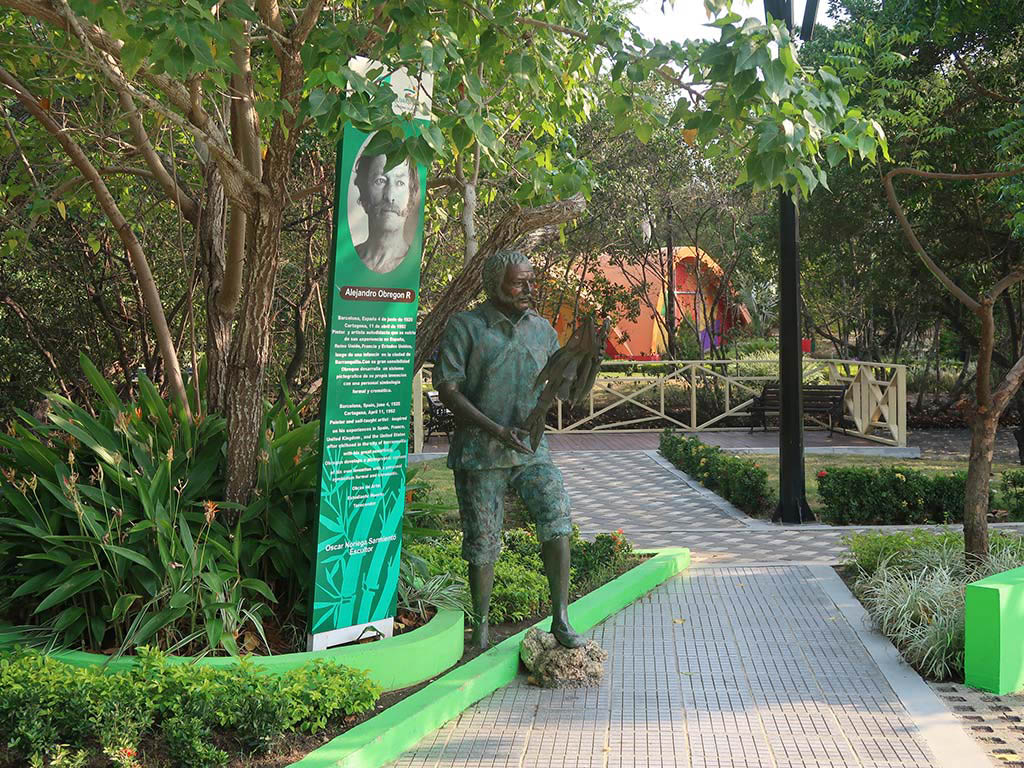
Totumo Mud Volcano Tour
About an hour away from the city lies a volcano with its crater filled with mud. One of the most touristy things to do in Cartagena is soaking in this mud for your body to absorb the rich minerals of the volcano, before washing it off in the nearby river.
Many people love this tour and the others absolutely hate it and often label this tour as a tourist trap. After reading about different experiences, we were not quite convinced about bathing in mud with dozens of other strangers in a small space. Hence we skipped this.
However, you may have a different perspective. So check out the Totumo Mud Volcano Tour for yourself (when we are on the other side of social distancing days) and let us know how you feel about it.
Trip to Rosario Islands
How can we discuss the best things to do in a city by the Caribbean and not include any beach in the list? Given its location, of course Cartagena has a few beaches. However, to get your beach time, we recommend you to leave the city and go on a trip to one or some of the nearby islands off the coast of Cartagena.
You can go on a day trip from Cartagena to Isla Baru or Isla Grande for pretty beaches. But to maximize your beach experience in Caribbean Colombia, without the crowd of day-trippers, stay overnight on one of the islands.
We chose to spend a couple of days at a beach hotel in the Rosario Islands. Apart from admiring the beauty of the pretty beach, we also enjoyed all of the activities, ranging from snorkeling in the ocean to watching an orange sunset. Can we ever get tired of palm trees swaying over white sand next to the Caribbean Sea?
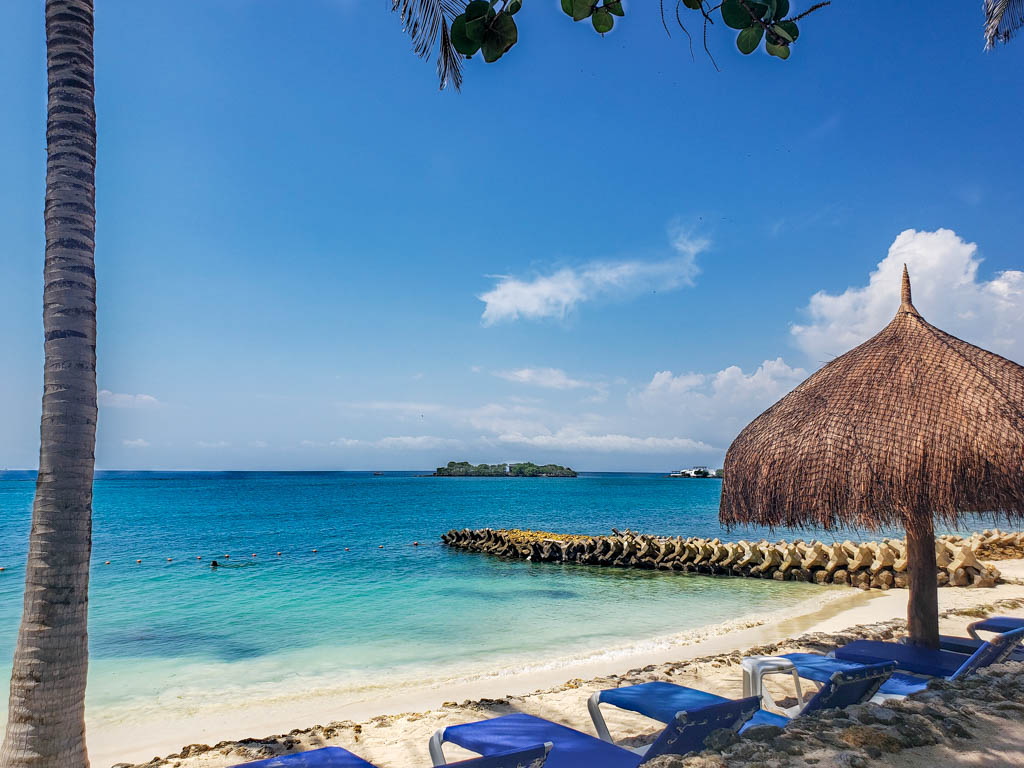
Bocagrande Beach
If you are pressed for time in Cartagena and would still prefer to sneak in a visit to the beach, head to Bocagrande. Let us remind you that Playa de Bocagrande is in no way comparable to the stunning Caribbean beaches that you see on postcards.We would still recommend an island visit instead of the city beaches in Cartagena.
Bocagrande beach lies in a modern urban part of the city that is characterized by high-rise sea-facing buildings, shopping malls, restaurants and bars. So you can mix and match city and beach holidays here, if that is your cup of tea.
The beach is usually thronged by locals, tourists and vendors. So, to enjoy Bocagrande beach, try to find a quieter end of the dark sand stretch in the late afternoon, watch the sunset and then chill in the evening at one of the pubs in the neighborhood with a refreshing Colombian cerveza.
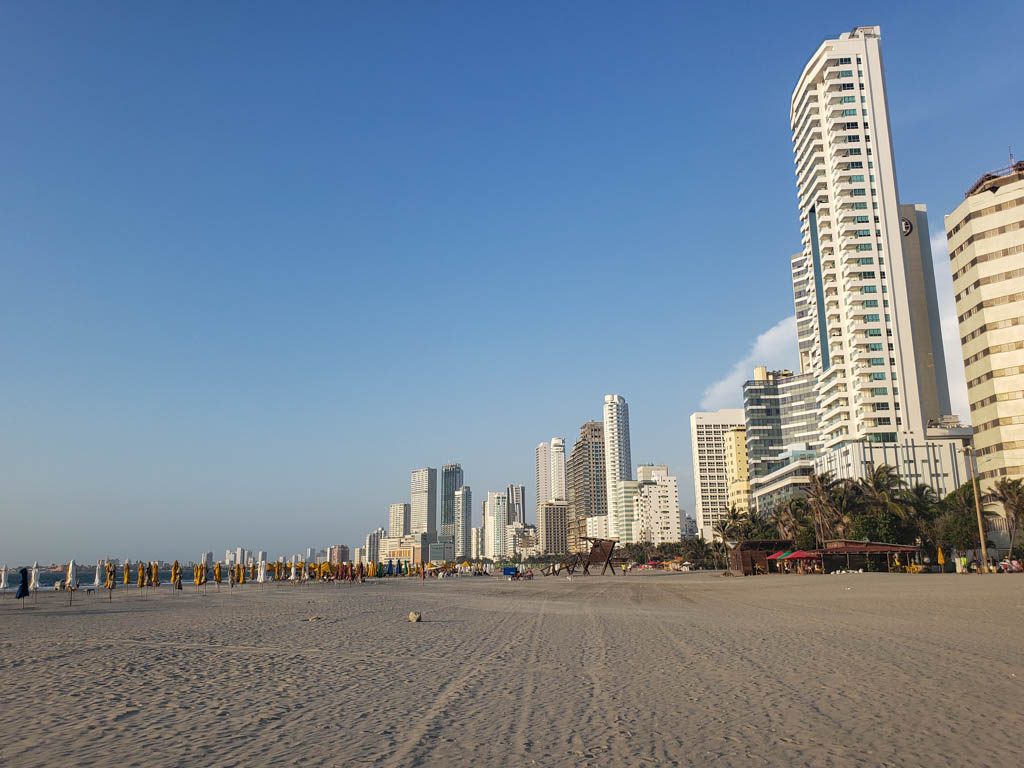
Hop-on Hop-off Bus Tour of Cartagena
If you have just landed in the town and still wondering where to begin, you can use the hop-on hop-off bus tour and get a glimpse of old and new parts of Cartagena. The buses run every 45 minutes and you can just buy a day pass and hop on. They will provide the map and the schedule along with the stops.
The advantage of the tour is that you can visit a few places without worrying much about the transport. Take a look at life in Cartagena, the streets and the lovely Colombian people and get an idea of the places you might wish to visit at a slower pace later.
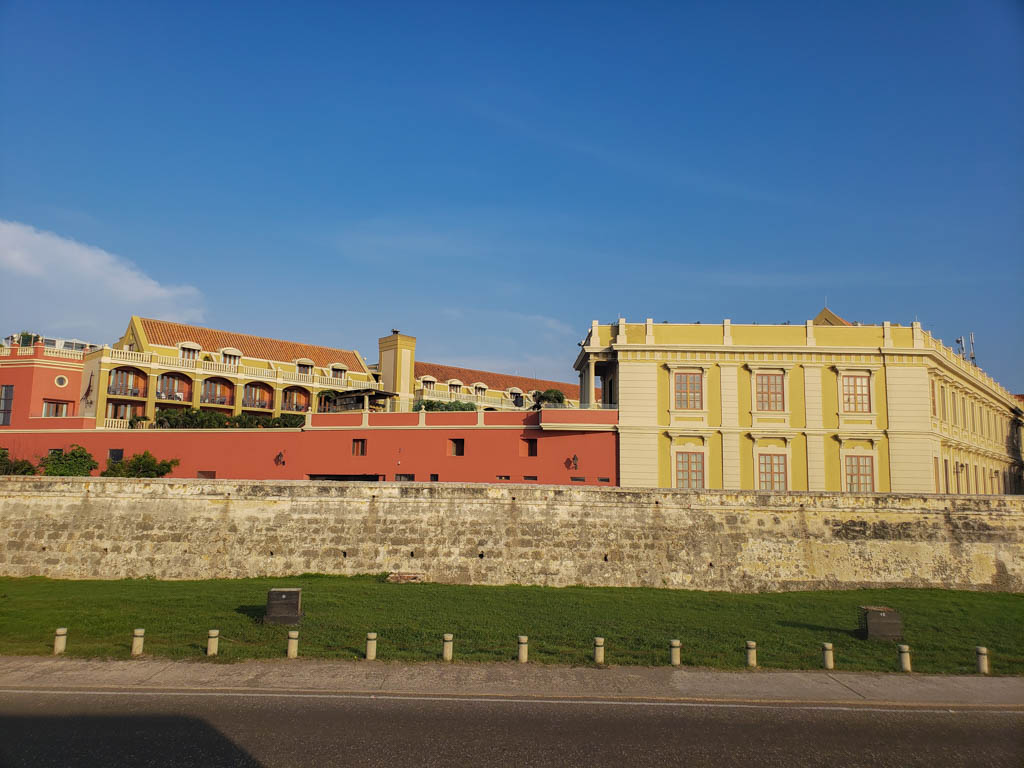
Cartagena: Make it happen
How to reach Cartagena?
Whether traveling internationally or domestically, you can fly in to Cartagena at the Rafael Núñez international airport. Syncing well with the colorful colonial style of the city, the airport arrival looks pretty with pink flowers clinging on to wooden framed walkways.
Cartagena is also connected by a good network of bus services with other important regions of Colombia, although we did not need to avail the same for arrival in/departure from Cartagena. In our travel itinerary, we flew from San Jose, Costa Rica to Cartagena, with a short layover at Bogota. For our onward journey from Cartagena to Salento, we flew to Pereira with Viva Colombia, a budget domestic airline in Colombia.
Where to stay in Cartagena?
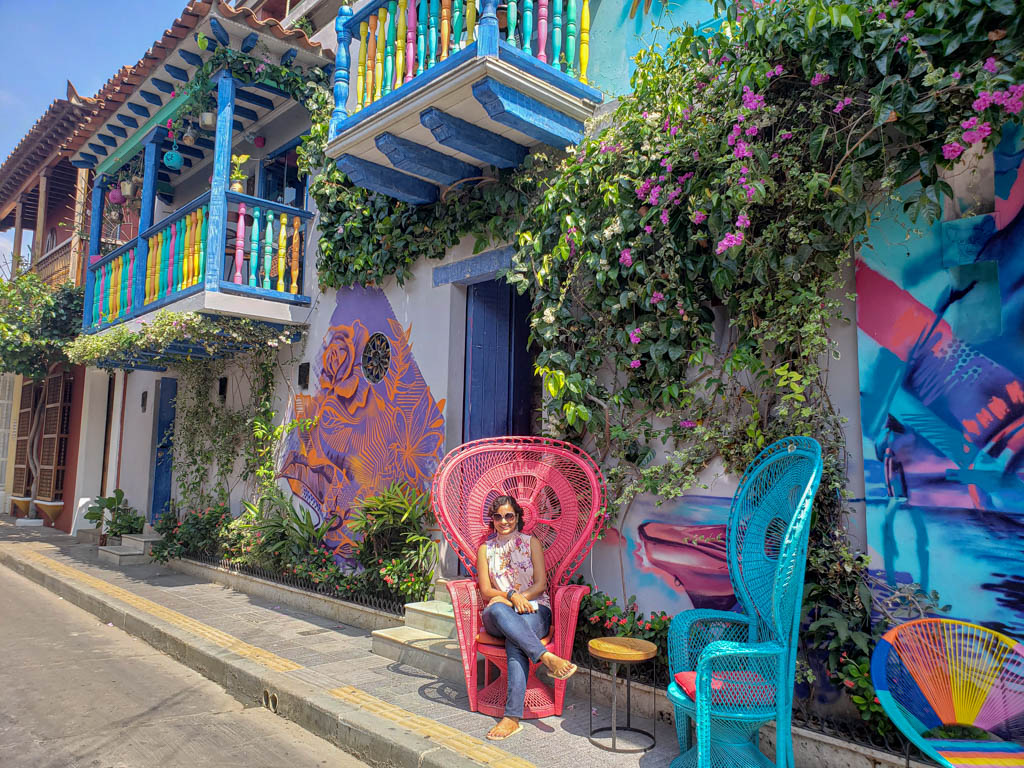
Walled City of Cartagena: We recommend staying in the Walled City of Cartagena. Many of the city’s attractions are located here, which you can explore on foot. While you are at it, stop at all the Insta-worthy cool spots for colorful photo ops. Also, in the Walled City, you will never be far from restaurants, bars and street food. There are plenty of hotels and hostels to choose from in the Walled City of Cartagena.
Getsemani: However, if you are looking for more backpacker vibes where you can meet other travelers and party together, look no further than Getsemani. This area also lies at an advantageous position of just outside the Walled City, thus you are still a walking distance away from all the attractions in the Walled City.
Bocagrande: Despite all the colorful vibes of Cartagena downtown, if you absolutely need to stay closer to the beach, Bocagrande can be a good option. But this area does not really represent the signature photos that you see of Cartagena on the internet. Bocagrande is more about modern urban infrastructure, with high-rise hotels and apartments by the beach.
Closing thoughts on Cartagena
The colonial charm, the vibrant colors, the local Caribbean food and getting lost in times in the alleys of the walled city will make Cartagena a must visit destination in your Colombia itinerary.
Look over the walls to the distant sun setting over the Caribbean Sea and wonder if the Florentinos are still looking for their Ferminas in the streets of the old town of Cartagena. Hope you find your own story.
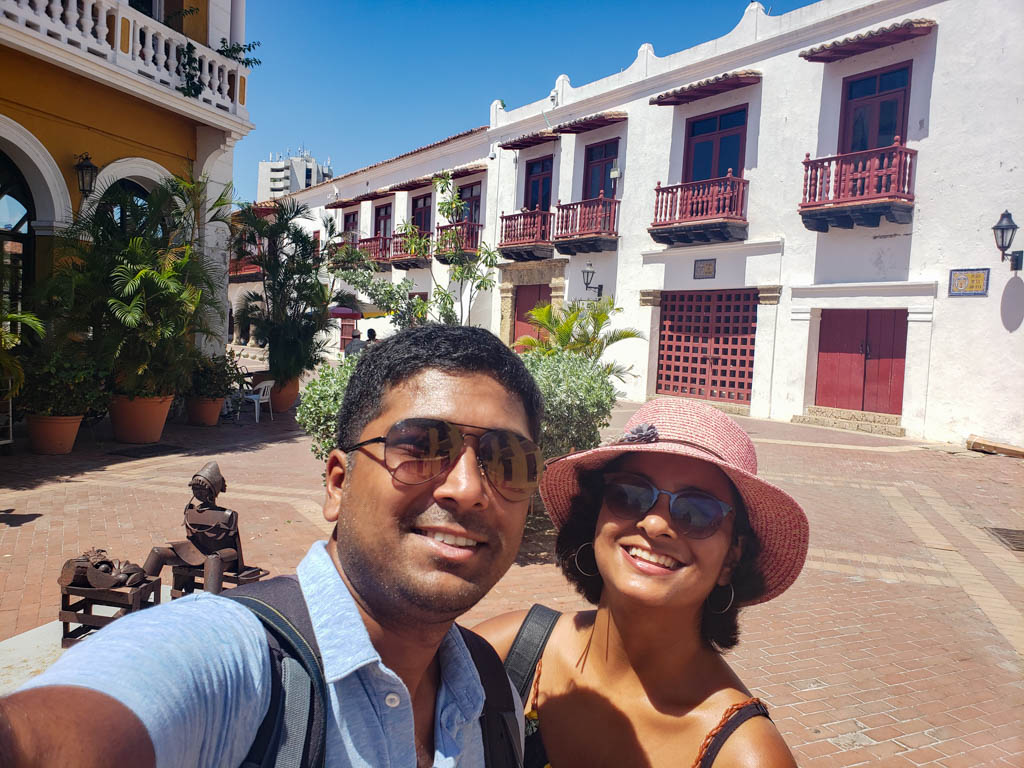
Like the post? Pin it!


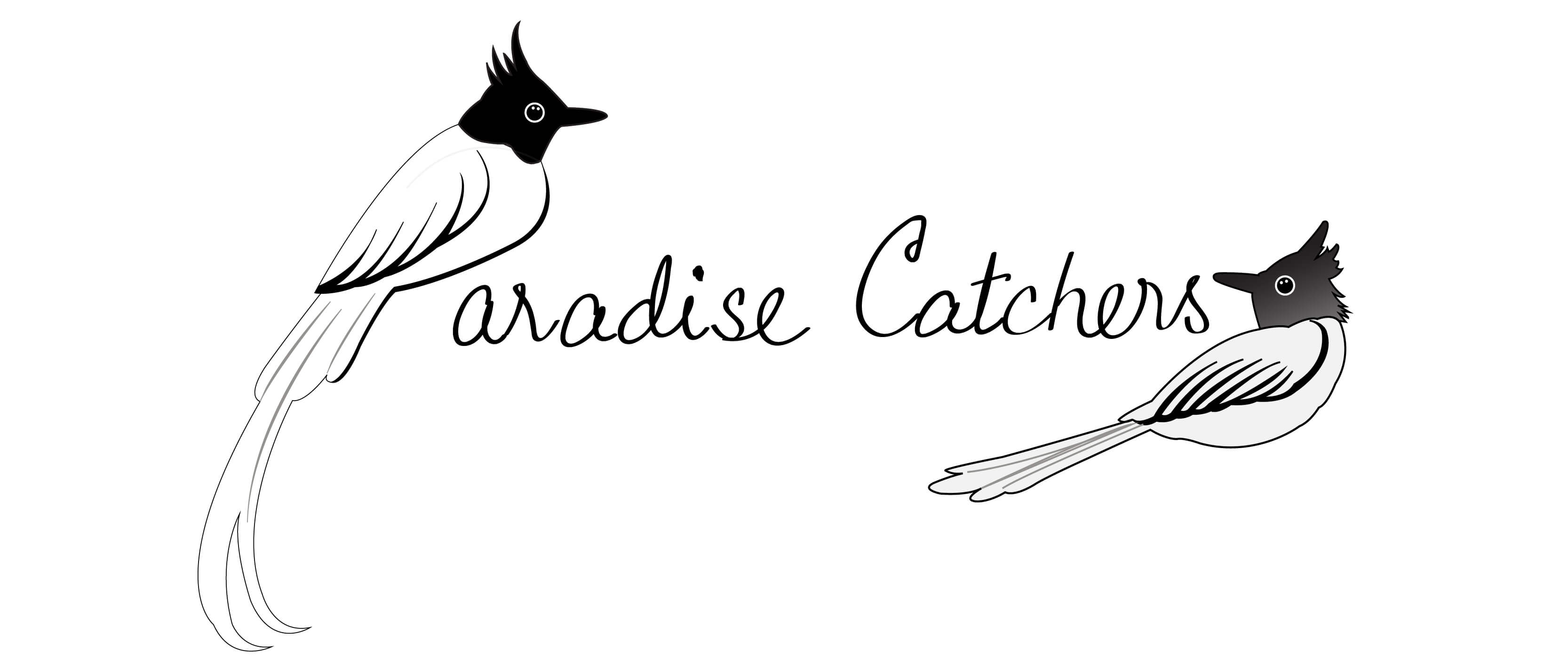
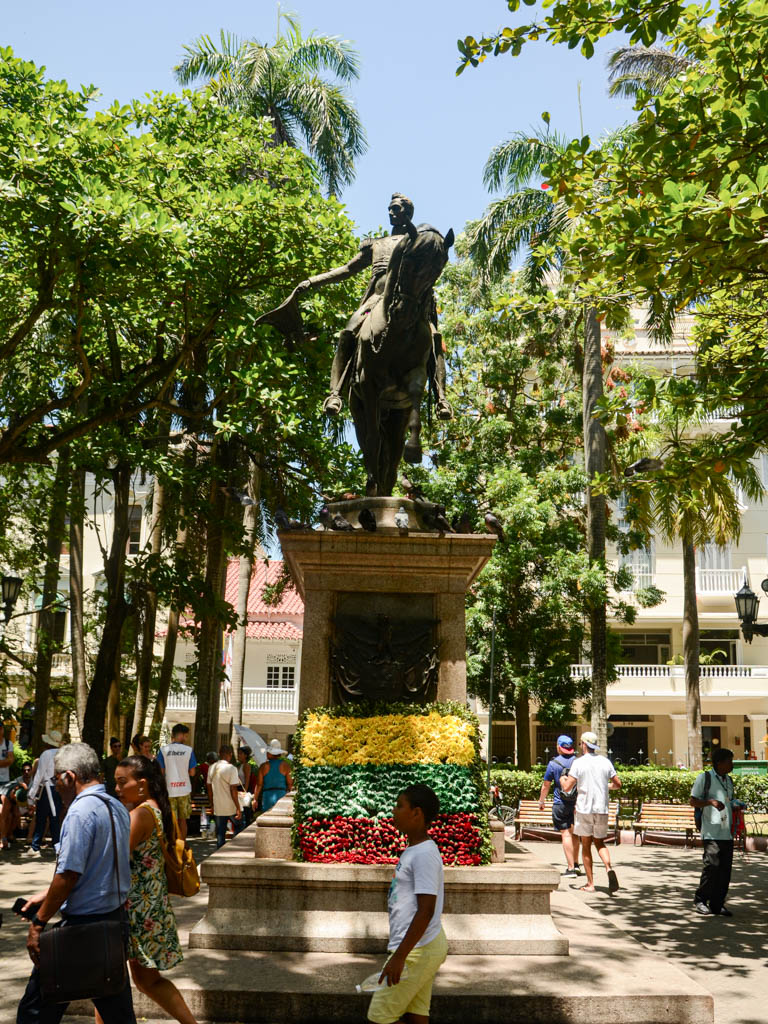
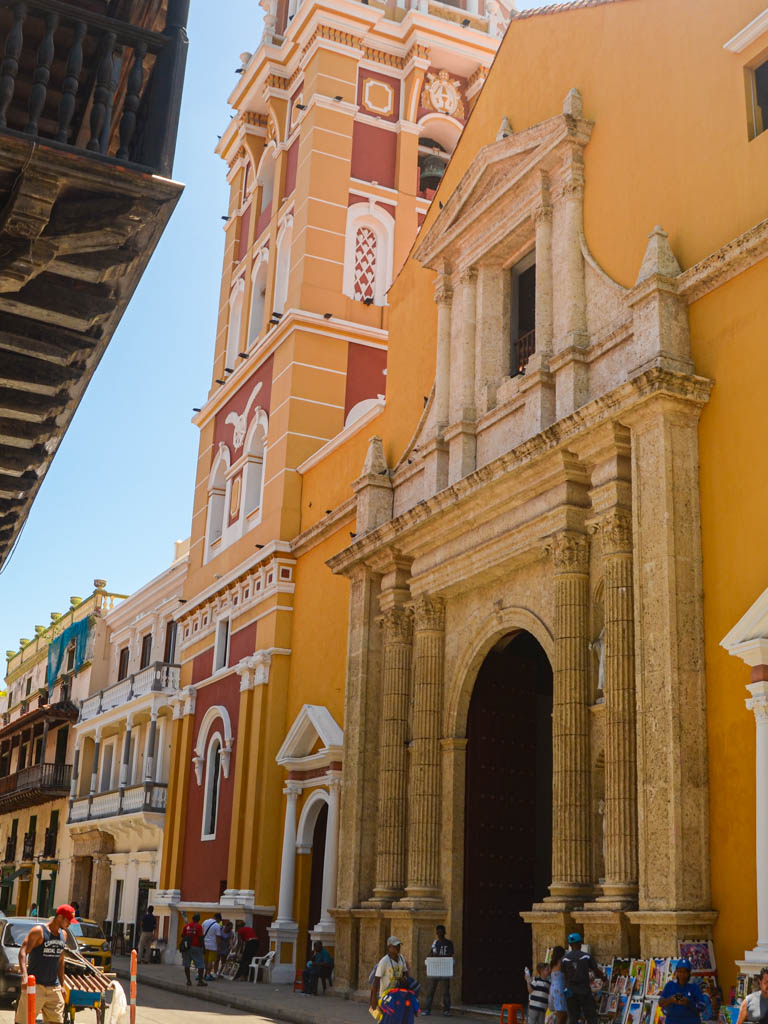
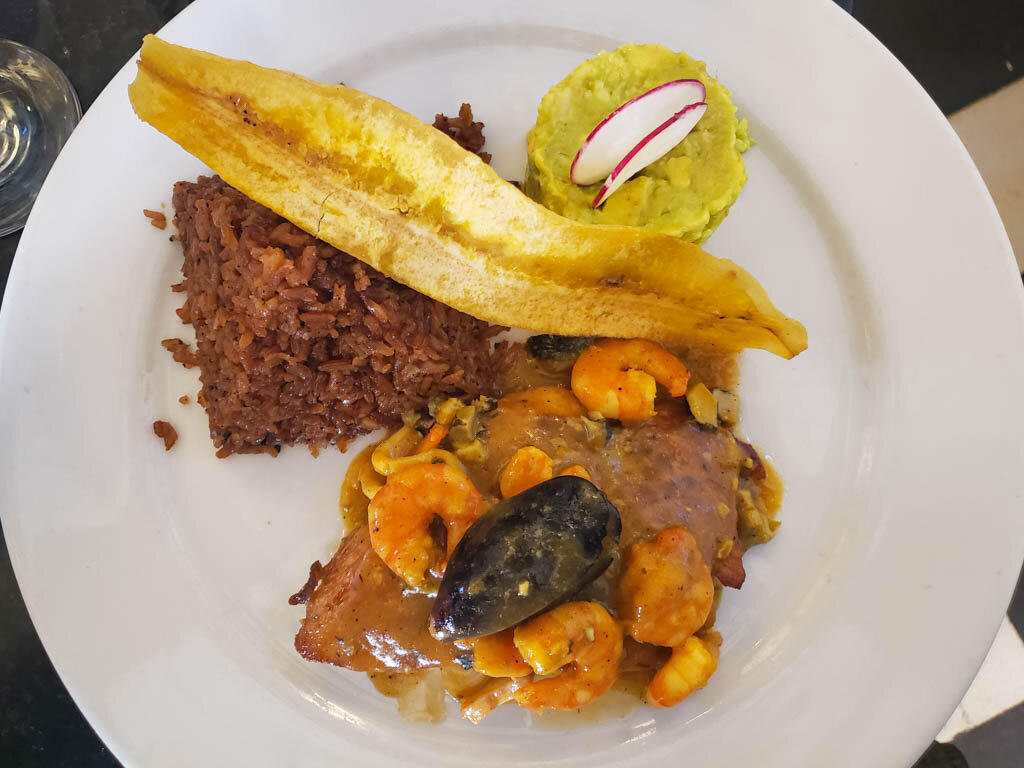
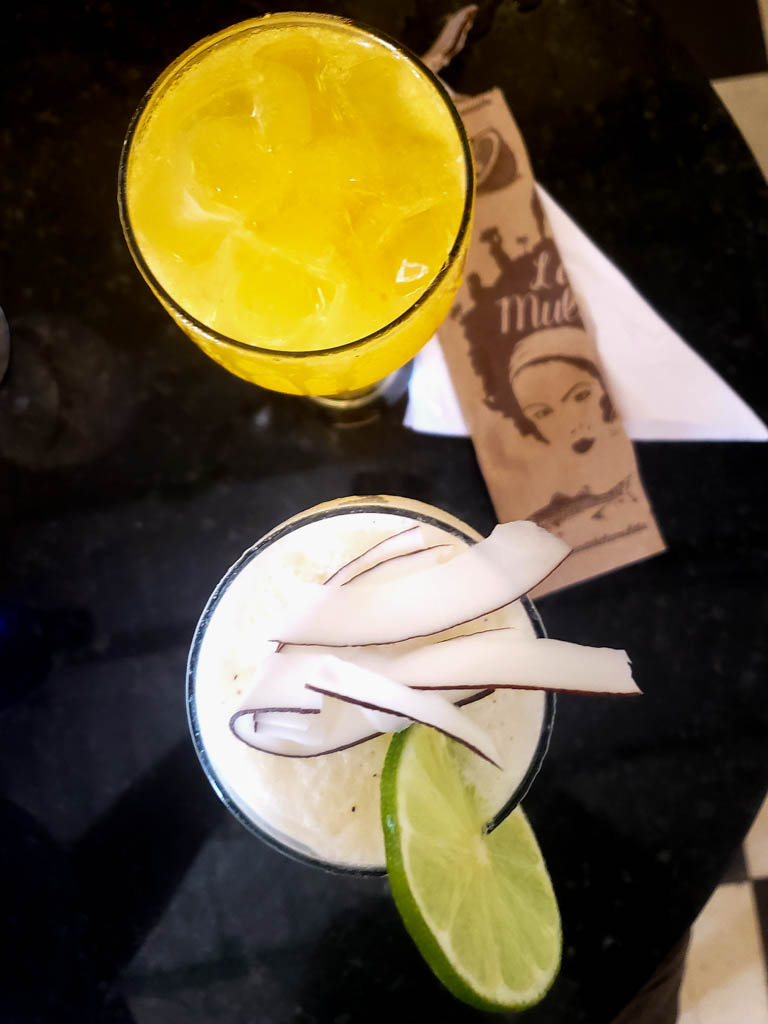
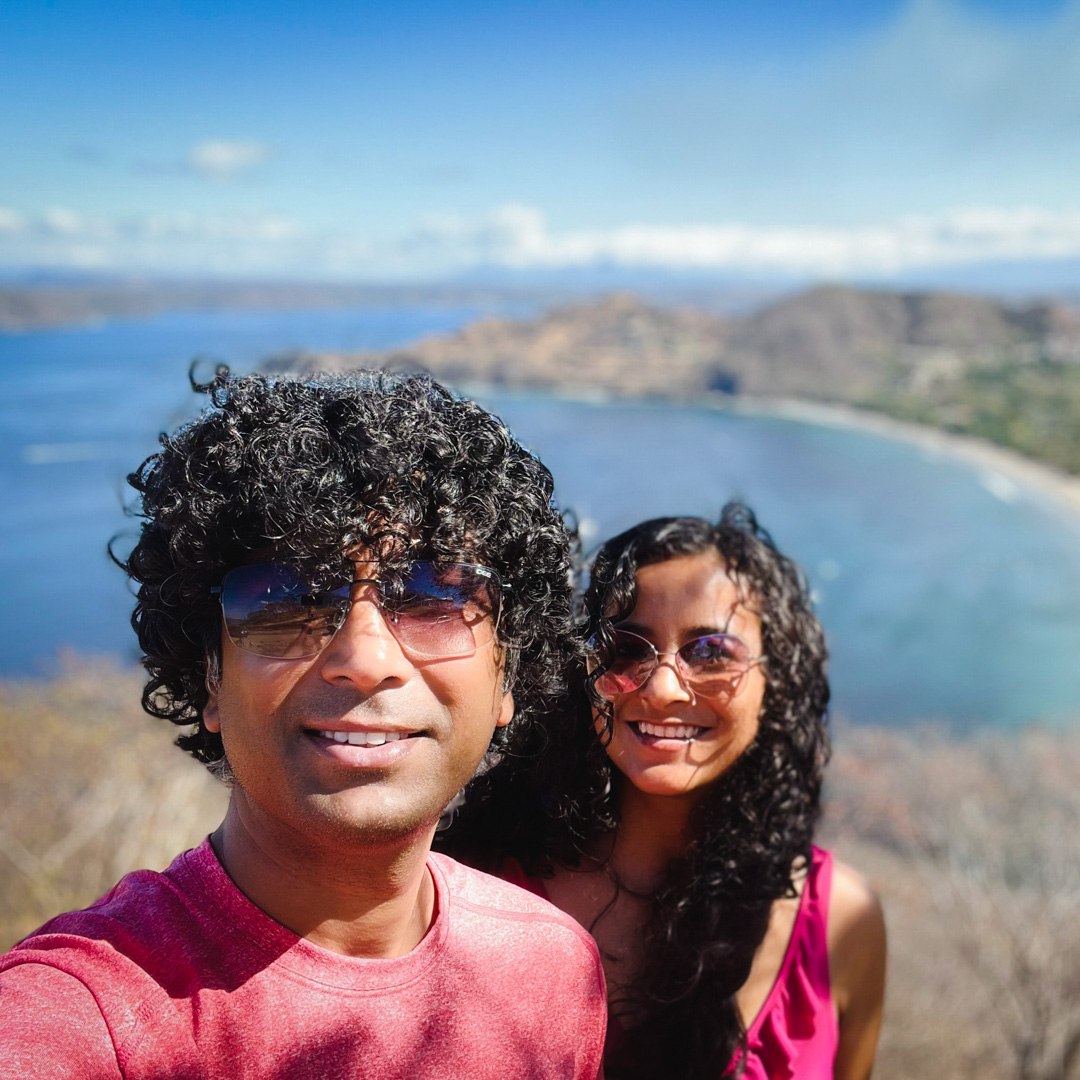
I always like to do the Hop-on, Hop-Off Tours to get an overview of the city and know where I want to do a deep dive.
Cartagena looks amazing. I would love to experience the history and culture of such an amazing city.
I’m getting all sentimental when I see these wonderful Colombian foods! Although Cartagena is not ‘Colombian’ enough for my taste, it’s undoubtedly vibrant and colorful. We also enjoyed really yummy drinks during happy hour which made us quite….happy 😉
Hi Renata, I am interested to learn more about how and why Cartagena is not Colombian enough to your taste. 🙂
What a comprehensive guide. I particularly liked the cultural and historical insight, for example your giving context and history to the Palenqueras selling fruit / photos. For me, that is essential when I’m researching my trips and deciding what to see. Ps I’m ready for the arepas!!!
Thanks Kavita. Yes, it is always interesting to know the backstory 🙂
You can actually see sloths in Cartagena?!? I am quite disappointed that I missed this! Fortunately, we saw a few in Costa Rica, but I’ll be looking out for the sloths when I come back to Cartagena. And you’ve already given me quite a bit of inspiration for a future trip, so I hope I’ll get to go back one day. 🙂
Exactly! Who would have imagined that there are sloths in a big city like Cartagena!
Glad to know that you were able to see a few in Costa Rica – we love this part about Costa Rica! 🙂
We were blown away by the beauty of the colorful buildings in the historic downtown area. For me, Cartagena has one of the most beautiful , if not the most beautiful, downtown areas in the world.
Agree Rudy, despite the hustle and bustle, Cartagena is quite charming.